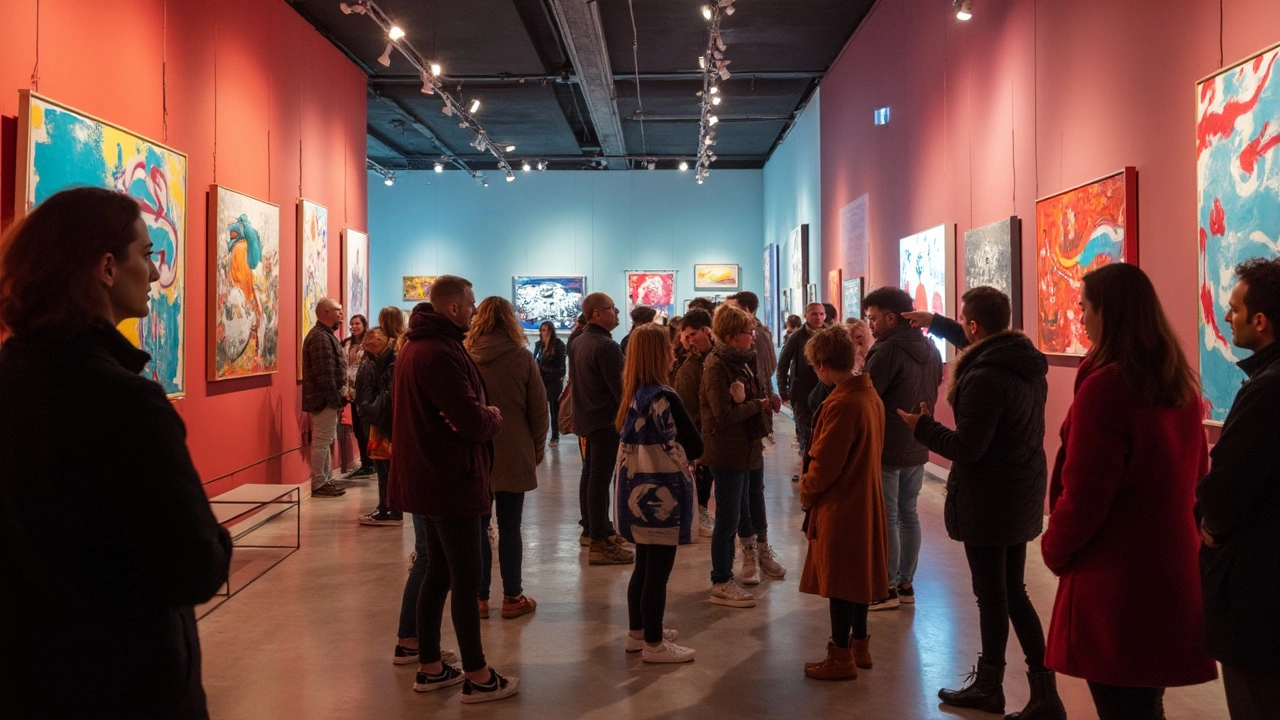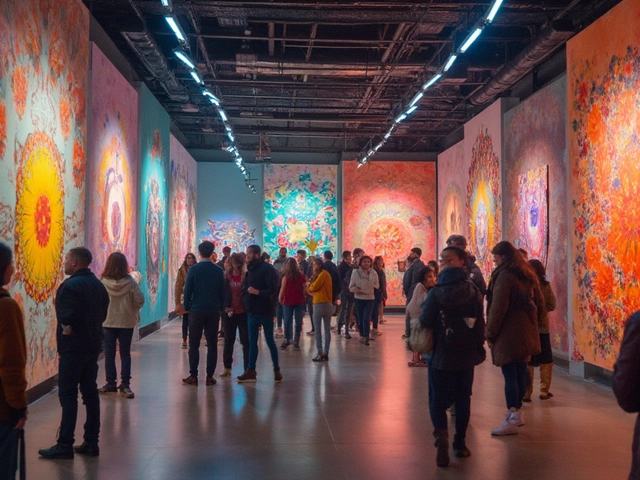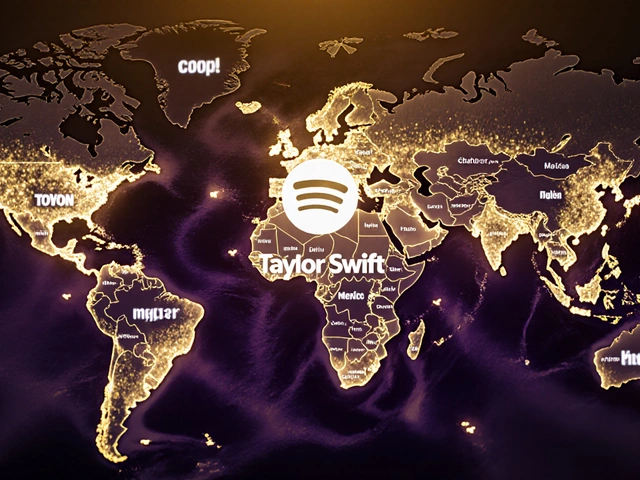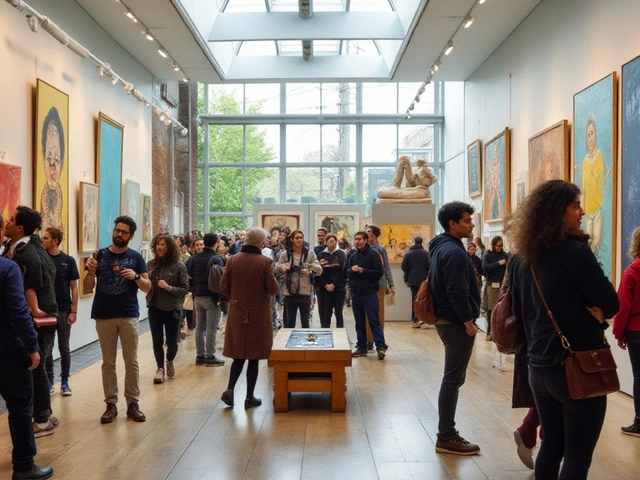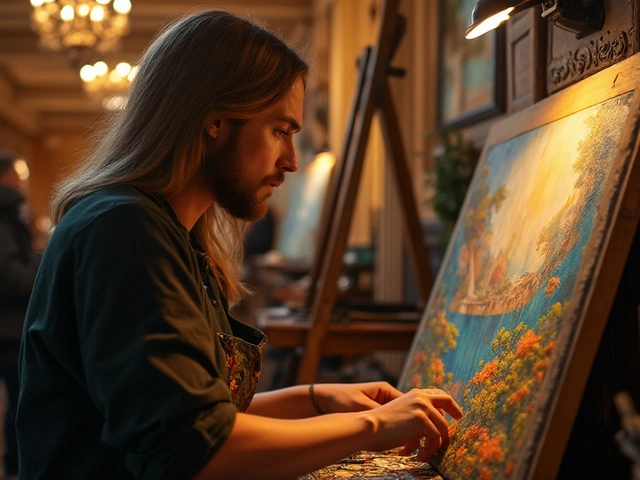Modern art isn’t about making things look pretty or realistic. It’s all about breaking rules and seeing what happens. People started ditching strict traditions around the late 1800s, and instead, they focused on their own feelings, wild ideas, and sometimes just pure chaos. Ever notice how some paintings from this era look like squiggles or odd blobs? That’s often on purpose. These artists wanted you to react, think, maybe even get angry or confused.
It’s not just about paint, either. Artists started using anything they could get their hands on—scraps of newspaper, bits of metal, even everyday junk. The main goal? To make something that made you stop and wonder, “What is this, and why does it exist?” If you’ve ever felt lost in front of a strange sculpture or a splattered canvas, you’re not alone—lots of people feel that way at first.
- How Modern Art Broke the Mold
- Key Traits of Modern Art
- Famous Modern Art Movements
- Why Modern Art Gets People Talking
- How to Spot Modern Art in Real Life
- Tips for Understanding and Enjoying Modern Art
How Modern Art Broke the Mold
Modern art didn’t just tweak a few old rules—it tore up the playbook. Before the late 1800s, most artists followed set formulas. Paintings were about smooth lines, perfect details, and mostly rich families or religious scenes. Then, artists like Claude Monet and Edgar Degas flipped the script. They focused on quick brush strokes and messy light effects, giving us that blurry, dreamlike feel we call Impressionism.
But things got even wilder. Pablo Picasso and Georges Braque jumped in with abstract shapes and Cubist experiments, breaking objects into weird blocks and angles. By the early 1900s, you’d see paintings with odd colors and no obvious subject at all. Wassily Kandinsky and Kazimir Malevich led the way in making art that didn’t look like anything in real life, which shocked everyone used to portraits and gentle landscapes.
- Innovation: Artists started using new materials—metal, collage, found objects—to create paintings and sculptures that just weren’t possible before.
- Self-expression: Instead of copying the world, modern artists showed off their own feelings and point of view. Art was about the artist as much as the picture.
- Breaking Tradition: Modern art ditched old rules about beauty and ‘proper’ technique. If you could think it up, you could probably turn it into art.
By World War I, artists were so fed up with how things had always been done, they made art from literally anything—Dadaists used trash and nonsense as statements, challenging what “real art” even means. You could say modern art wasn’t just about looks. It was about changing ideas, shaking things up, and never settling for the usual. This shift didn’t just spark debates; it changed the art world forever.
| Year | Major Breakthrough |
|---|---|
| 1874 | First Impressionist Exhibition |
| 1907 | Picasso Paints Les Demoiselles d'Avignon |
| 1916 | Birth of Dada Movement |
Key Traits of Modern Art
If you want to spot modern art, look for what makes it stand out from the classic stuff. Modern art is never just about copying what you see with your eyes. Instead, it’s about showing new ideas, personal feelings, or playing with materials and colors in ways nobody tried before. Here’s what sets it apart:
- Innovation: Artists often throw out the rulebook. No more strict perspective or perfect anatomy; now it’s about exploring new forms, techniques, and styles. Picasso once painted faces with eyes on the side and noses that looked like triangles—just to try something different.
- Abstract Elements: You won’t always find clear pictures or lifelike people. Sometimes shapes, lines, and colors carry the whole message. Think about famous works like Kandinsky’s or Mondrian’s: grids, bold blocks of color, squiggles, and dots.
- Self-Expression: This is where feelings come first. Artists poured their moods, struggles, and even big social issues into their work. It goes way beyond just skill—sometimes it’s messy, raw, or even a little weird on purpose.
- Experimenting with Materials: Oil paint wasn’t enough anymore. Modern artists started gluing, stacking, and mixing media. You might see wood pasted onto a canvas, metal scraps, or even found objects from a junkyard put together as a "sculpture."
- Focus on Process: The steps artists take to create the work often matter as much as the end result. Jackson Pollock’s wild way of dripping paint is a perfect example—the act of painting was part of the art.
Here’s a quick look at how some of these traits show up in actual works:
| Trait | Example Artist | Famous Work |
|---|---|---|
| Abstraction | Piet Mondrian | "Composition with Red, Blue, and Yellow" |
| Process | Jackson Pollock | "No. 5, 1948" |
| Self-Expression | Edvard Munch | "The Scream" |
| New Materials | Pablo Picasso | "Still Life with Chair Caning" |
| Breaking Traditions | Marcel Duchamp | "Fountain" |
So, if you come across art that makes you scratch your head or feels out of the ordinary, chances are you’re looking at something shaped by one (or more) of these key modern art traits.
Famous Modern Art Movements
Modern art is packed with wild ideas and different styles, so it helps to know the big movements that changed everything. Let’s break down some heavy hitters, the real game changers that keep popping up in books, museums, and pretty much every serious talk about modern art.
- Impressionism: This was like a wake-up call in the late 1800s. Artists like Monet and Renoir started painting scenes as they saw them, with quick brushstrokes and bright, loose color. No more getting every detail perfect—these guys wanted to capture light and feeling. People seriously freaked out when these paintings first hit the scene. Now, they’re in every major museum.
- Expressionism: Think big emotions, bold color, and off-kilter shapes. This movement, with folks like Edvard Munch and Ernst Ludwig Kirchner, turned feelings into vision. The point wasn’t reality—it was mood. You probably know The Scream: total expressionist energy.
- Cubism: Picasso and Georges Braque ripped up the rulebook in the early 1900s. Instead of trying to make things look real, they broke up objects into blocks and weird angles. Regular stuff—like guitars or faces—came out looking totally different, but you could still sort of tell what it was.
- Futurism: This started in Italy and blasted into the early 20th century, obsessed with speed, cars, and new tech. Art looked mechanical and busy. Everything was always moving, which lined up with an era buzzing with invention.
- Abstract Art: This movement said, “Who needs objects at all?” Artists like Kandinsky and Mondrian just played with lines, colors, and shapes. Sometimes, these works look like they have no meaning, but for the artists, it was all about exploring what colors and shapes could make you feel.
- Surrealism: Born in the 1920s, this movement loved weird dreams and strange ideas. Salvador Dalí, with his melting clocks, led the charge. Artists were inspired by dreams, the subconscious, and the stuff no one dared talk about.
These modern art movements didn’t just change how art looked; they made regular folks question what art even is. A lot of what we see in today’s galleries—abstract paintings, mixed media, or art that you’re not sure is art at all—owes a lot to these trailblazers.
| Movement | Key Figure | Debut Era |
|---|---|---|
| Impressionism | Claude Monet | 1870s |
| Expressionism | Edvard Munch | 1900s |
| Cubism | Pablo Picasso | 1910s |
| Futurism | Umberto Boccioni | 1910s |
| Abstract Art | Wassily Kandinsky | 1910s |
| Surrealism | Salvador Dalí | 1920s |
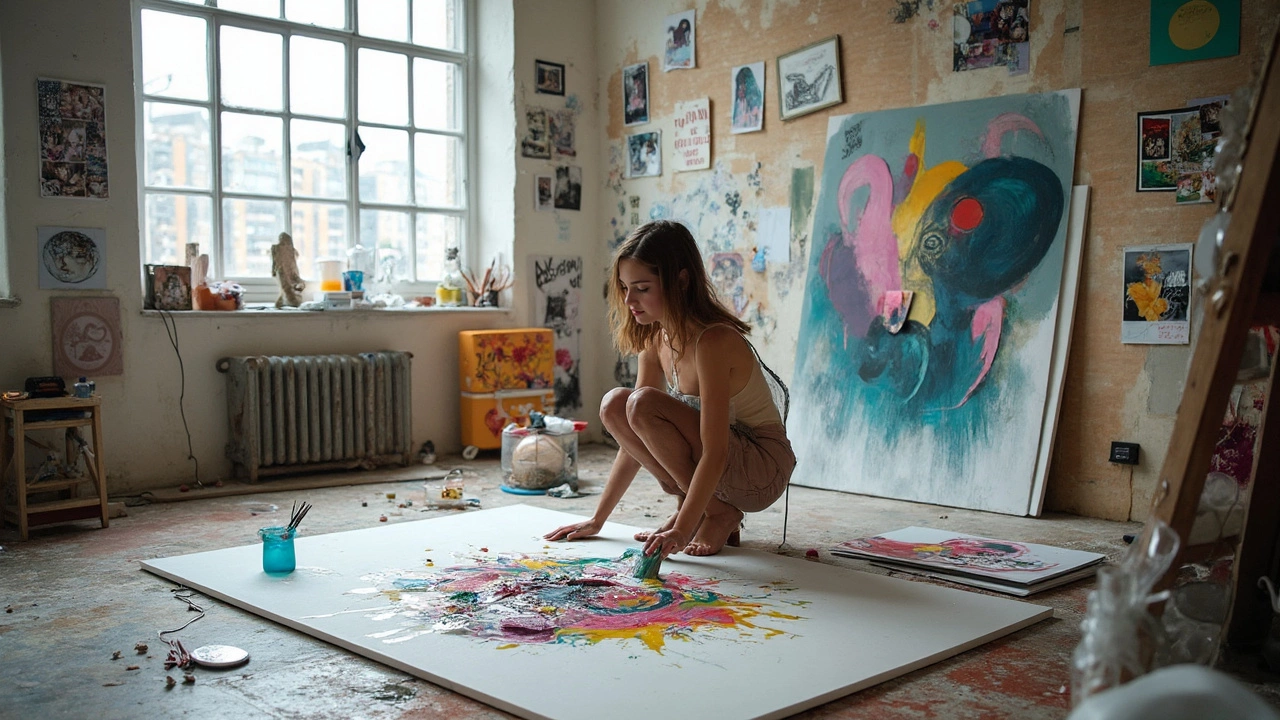
Why Modern Art Gets People Talking
Walk into any gallery with modern art and you'll hear people debating everything from "Is this really art?" to "Why did the artist make this choice?" The reason is simple: modern art isn't here to blend in. It's built to spark reactions, challenge what we think counts as art, and sometimes just mess with our heads.
One big reason modern art stands out is its focus on ideas more than looks. Take Marcel Duchamp's "Fountain," from 1917—that's the one where he put a urinal in a gallery and called it art. People were shocked, and critics argued whether it was genius or just trolling. The point was to ask, "What makes something art—the object, or the idea behind it?"
Modern art also pushed boundaries around social issues. In the 1930s, Diego Rivera painted murals covered in political messages, while artists like Pablo Picasso didn’t shy away from showing the uglier sides of war and human suffering; "Guernica" is a literal billboard for anti-war emotion. Because of choices like these, modern art keeps getting dragged into conversations about politics, culture, and morality.
Sometimes, it's the sheer price tag that gets people talking. Did you know Mark Rothko’s simple color block painting "Orange, Red, Yellow" sold for $86.9 million in 2012? People love to argue about why a painting that looks so basic commands such a jaw-dropping price.
| Artwork | Artist | Year Sold | Sale Price |
|---|---|---|---|
| Orange, Red, Yellow | Mark Rothko | 2012 | $86.9M |
| No. 6 (Violet, Green and Red) | Mark Rothko | 2014 | $186M |
| Le Rêve | Pablo Picasso | 2013 | $155M |
And, let’s be honest—modern art just looks different. You might see plain geometric shapes, wild colors, or materials like rusty metal and plastic. People argue because it doesn’t fit what they think “art” should be. That’s kind of the point. If you’re debating whether you love it or hate it, modern art has done its job right.
When you spot modern art making headlines or fueling heated online threads, it’s usually because it’s poking at something deeper—our taste, our beliefs, even our wallets. And as long as it keeps doing that, people will keep talking.
How to Spot Modern Art in Real Life
Walking into a museum or gallery, you can spot modern art by looking for a few key hints. One of the biggest giveaways? It usually doesn’t look like real life. Forget perfect landscapes or fancy portraits—think bold colors, strange shapes, and stuff that sometimes makes you scratch your head. Modern artists wanted to shake things up by using new styles, materials, and ideas.
Here are some solid clues that you’re face-to-face with modern art:
- Abstract shapes or forms: If you see art with squiggles, blocks, or shapes that don’t really look like anything, that’s a telltale sign.
- Unexpected materials: Modern artists love experimenting. If you see pieces made from everyday items—like Pablo Picasso’s famous bull sculpture made from a bike seat and handlebars—you’re in the modern zone.
- Emotional punch: Sometimes the art just feels intense or kind of weird, like Edvard Munch’s "The Scream." Modern art is all about sharing feelings, not just pictures.
- No rules: Modern art often ignores the typical "rules" of art. Things might look unfinished or messy on purpose. Nothing about it screams "traditional."
- Bold, simple colors: Think of Henri Matisse’s "The Snail," made with big blocks of super-bright paper. It stands out in any room.
When you enter a modern art exhibit, take note of when the work was created. Art from roughly the 1860s to the 1970s usually falls in this category. To make it easier, here’s a quick peek at where you’re likely to find these pieces:
| Place | Modern Art Focus? |
|---|---|
| The Museum of Modern Art (MoMA), New York | Yes |
| Tate Modern, London | Yes |
| Local city museum (random) | Maybe—look for modern exhibits! |
A good tip is to read the sign next to the artwork. If you spot names like Kandinsky, Mondrian, Duchamp, or Pollock, you’re in modern territory. The more you look, the easier it gets to tell modern art from the rest.
Tips for Understanding and Enjoying Modern Art
There’s no secret handshake or membership card you need to enjoy modern art. If it looks confusing or random at first, don’t sweat it—that’s a common reaction. Here’s how you can make sense of it and actually have some fun along the way.
- Ignore the "right" answer. The meaning often isn’t straightforward or even important. It’s usually about what you feel or think, not what some expert thinks you should see. Stand there, have a look, and ask yourself: does it remind me of something? Does it make me feel anything?
- Read the wall label. Most museums or galleries give you at least a title, date, and sometimes a short story about the piece. For instance, Kazimir Malevich’s “Black Square” blew people’s minds in 1915 because it was literally just a black square. In context, that was a wild move back then.
- Find out about the artist’s life. Artists like Frida Kahlo or Jackson Pollock made very personal work. Knowing that Frida was often in pain from injuries, or that Pollock invented his own way of painting by drip, helps the weirdest paintings make more sense.
- Try to spot what’s new. One thing that marks modern art is breaking rules. Did the artist use weird materials? Was this technique new at the time? In 1917, Marcel Duchamp shocked everyone by submitting a urinal as "art." He called it "Fountain." That changed art forever—suddenly, the idea behind the work mattered just as much as the work itself.
- Don’t rush. Give yourself a minute, even for stuff you don’t get right away. Modern art is full of surprises—sometimes it grows on you as you look longer.
If you’re visiting an exhibition or scrolling online, here’s a helpful breakdown of the most common types of modern art you might run into:
| Style | Common Traits | Famous Example |
|---|---|---|
| Abstract | Shapes, colors, not meant to look realistic | Piet Mondrian’s “Composition with Red, Blue and Yellow” |
| Surrealism | Dream-like, weird scenes | Salvador Dalí’s “The Persistence of Memory” |
| Pop Art | Everyday images, bold colors | Andy Warhol’s “Campbell’s Soup Cans” |
Last tip: chat with someone else about what you see, even if they totally disagree with you. Sometimes, another person’s take opens your eyes to something you missed. Modern art isn’t about being right—it's about looking, thinking, and maybe even laughing or arguing a bit.
